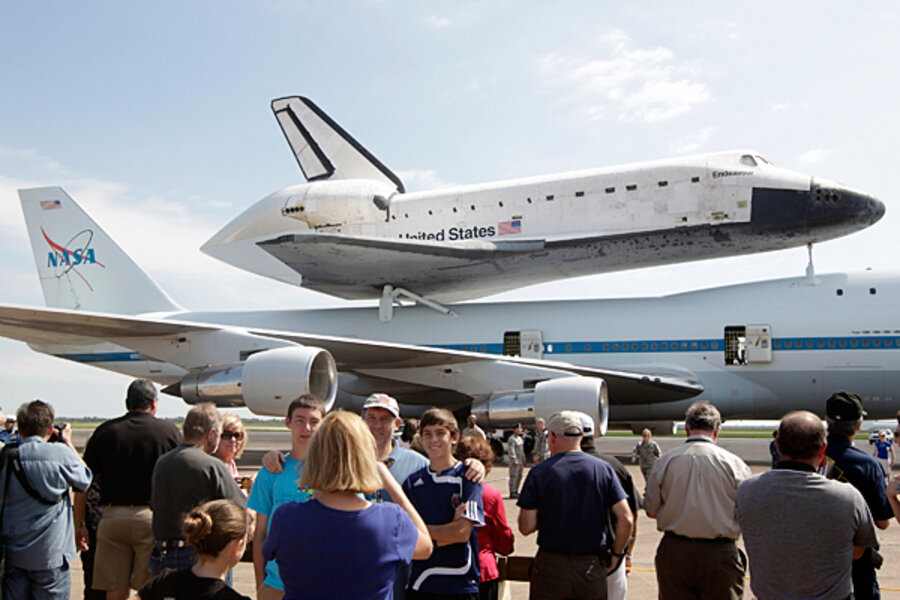Shuttle Endeavour heading to L.A. to retire: why some neighbors are ruffled
Loading...
| Los Angeles
Space shuttle Endeavour is being cheered as it soars cross-country into a Tinseltown retirement, but here in Los Angeles the ex-NASA behemoth is getting a cool reception from some of its future neighbors.
That’s because the job of transporting a 172,000-pound, five-story-high, 78-foot-wide space artifact is, well, a mighty endeavor. And some 395 Los Angeles trees are being forced to give up their place in the sun to make way for its 12-mile trek in October from the Los Angeles airport to its new home at the California Science Center (CSC) in downtown.
Endeavour, which flew 25 space missions before being grounded, is scheduled to land in Los Angeles midday Friday.
Despite months of intensive planning and a $200 million price tag for a five-year plan to house and promote the shuttle at the CSC, officials were still meeting with local residents Monday, the day the shuttle was initially supposed to depart the Kennedy Space Center (but was delayed because of weather). Behind closed doors, talks were conducted over such issues as how many trees may need to be removed from neighborhoods for the shuttle as it passes at 2 miles per hour through city streets.
In a statement following the rancorous meeting, even as residents continued to voice disappointment to local media, CSC president Jeffrey Rudolph said, “We are pleased that we are on track to move the Endeavour to the Science Center, where it can deliver substantial educational and economic benefits to the South Los Angeles community and the state of California.”
He noted that the center plans to move forward with a newly revised tree replacement program, which, he says, “will improve the streetscape in the South Los Angeles, Westchester, and Inglewood communities with nearly 1,000 new trees.”
The original plan, which had included a 2-for-1 tree replacement offer, has now been raised to more than 3-for-1. The tree replacement program follows CSC efforts over the years to create a park and landscaping that beautifies the neighborhood and provides recreational space for wide usage, Mr. Rudolph says.
According to the CSC, more than half the trees already had been scheduled for removal to enhance airport security or to make way for a Metro construction project, and another 20 are “environmentally unfriendly” trees that are damaging sidewalks and streets.
The new trees will be between 10 and 14 feet tall, and they will reach approximately the same size as most of the trees they are replacing in about two to five years. The CSC will also provide free maintenance.
Nonetheless, residents continue to voice their frustrations with the manner in which the shuttle arrival has been handled. How things went shows that when city officials want something, they will find a way, even if the plan has seemingly insurmountable hurdles – in this case, hundreds of mature trees, says Los Angeles activist and blogger Jasmyne Cannick.
Before the city “decided to chop down the trees and change the landscape of the city, it should have asked the people who were going to be affected by the changes instead of moving forward and going back and making amends after the damage is done,” she says via e-mail. Too often, she continues, “this is how business is conducted when it comes to certain communities.”
However, Los Angeles Mayor Antonio Villaraigosa has been ebullient in his support.
“Los Angeles is a world-class city that deserves an out-of-this-world-attraction like the Endeavour,” he said in a statement, adding, “We welcome the shuttle with open arms.”
From a national perspective, Washington-based media strategist Brendan Kownacki suggests that environmental concerns are secondary to the symbols of goals Americans cherish, such as space exploration. “This is a great symbol of what we are capable of doing,” he says. If there’s any doubt about the value Americans place on manned spaceflight, he says, look no further than the tributes after the recent passing of astronaut Neil Armstrong. “We gave him a hero’s send-off,” he says.
While saying he is deeply saddened by the loss of any mature trees, Edward Devinney, professor of astronomy and astrophysics at Villanova University in Pennsylvania, says, "Still, this is an amazing device and says a lot about what we can do.”
The object itself is important, he adds, for the simple fact that “people will look at it and say, this is really impressive that we were able to put that up there.”







